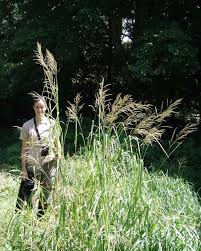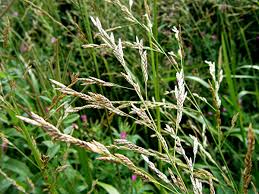Sweet grass is a delightful plant that has been cherished by various cultures for its pleasant fragrance and symbolic significance. It is a type of grass with a sweet, vanilla-like aroma, which is why it got its name. This fragrant grass is often used for spiritual and ceremonial purposes.
Sweet grass is native to North America and has a long history of being used by Indigenous peoples. They would weave the grass into braids and burn it as incense during sacred rituals, believing that its scent would purify the air and attract positive energy. The sweet aroma of burning sweet grass is said to bring peace and harmony to the surroundings.
Besides its ceremonial uses, sweet grass has also been valued for its medicinal properties. Some traditional healers have used it to treat various ailments, such as colds and headaches. Additionally, sweet grass is known for its calming effects, making it a popular choice for relaxation and stress relief.
In recent times, sweet grass has gained popularity outside of Indigenous communities as well. People have started using it as a natural air freshener and even as an ingredient in perfumes and scented products. Its unique fragrance has a soothing and uplifting effect, making it a favorite for aromatherapy enthusiasts.
Conservation efforts have been put in place to protect sweet grass, as it is a valuable part of cultural heritage and ecological diversity. Cultivating and harvesting sweet grass sustainably ensures that it can be enjoyed by generations to come.
In addition, Sweet grass is a remarkable plant with a rich history and significance. Its sweet and pleasant aroma has made it a beloved part of ceremonies, healing practices, and everyday life. Let us cherish and respect this gift from nature, embracing its beauty and the cultural wisdom it carries.
Read Also: All You Need to Know About Small Wild Cats
Complete Growing and Care Guide of Sweet Grasses

Growing and caring for sweet grass (Hierochloe odorata) can be a rewarding experience. Here’s a complete guide to help you cultivate this delightful plant:
1. Choosing the Right Location: Sweet grass thrives in full to partial sunlight. Select a location in your garden or outdoor space that receives at least 4-6 hours of sunlight daily. Ensure the soil is well-draining and slightly acidic for optimal growth.
2. Planting Sweet Grass:
a. You can start sweet grass from seeds or transplants. If planting from seeds, sow them in early spring or late fall, as they require a period of cold stratification for germination. Alternatively, use transplants to establish the grass more quickly.
b. Prepare the planting area by loosening the soil and removing any weeds or debris.
Plant the seeds or transplants about 1/4 to 1/2 inch deep in the soil, and space them at least 6-12 inches apart to allow ample room for growth.
3. Watering:
a. Sweet grass prefers consistent moisture but is also tolerant of dry conditions once established. Water regularly during the first growing season to help the roots establish.
b. In subsequent years, water during dry spells or when the soil feels dry to the touch. Avoid overwatering, as sweet grass can be sensitive to excessive moisture.
4. Fertilizing: Sweet grass typically does not require heavy fertilization. If needed, apply a balanced, slow-release fertilizer in the spring to provide essential nutrients for healthy growth.
5. Pruning: Sweet grass does not require frequent pruning. However, you can trim it in late fall or early spring to remove dead or damaged blades. This helps promote new growth and maintains a neat appearance.
6. Harvesting Sweet Grass:
a. Sweet grass is usually harvested in the late summer when it reaches its peak fragrance and before the seeds disperse.
b. Gather the grass in small bunches, ensuring not to damage the roots or pull the entire plant. Leave enough grass behind for the plant to regrow and continue thriving.
7. Drying and Preserving Sweet Grass: Once harvested, bundle the sweet grass in small bunches and hang them upside down in a cool, well-ventilated area to dry. Ensure the bunches are not too dense to allow proper airflow.
Store the dried sweet grass in airtight containers to preserve its delightful fragrance for use in various applications.
8. Uses of Sweet Grass: Sweet grass is commonly used for smudging and aromatherapy to create a calming atmosphere and purify spaces.
It can also be used in crafting, such as making sweet grass braids or adding it to potpourri for its pleasing scent.
By following these growing and care guidelines, you can successfully cultivate sweet grass and enjoy its cultural significance and aromatic charm in your garden or home. Remember to be mindful of the plant’s natural populations and harvest responsibly to ensure its preservation for future generations.
Read Also: Jungle Cats Description and Complete Care Guide
Importance of Sweet Grasses

Sweet grasses, especially Hierochloe odorata, hold significant economic importance in various ways:
1. Cultural and Spiritual Value: Sweet grass has profound cultural and spiritual significance, particularly among Indigenous communities. It is used in ceremonies, rituals, and smudging practices, creating a demand for sweet grass within these cultural contexts.
2. Crafting and Artisanal Industries: The aromatic and visually appealing nature of sweet grass makes it a sought-after material for crafting. Sweet grass braids are popular decorative items, and artisans incorporate sweet grass into various crafts, such as baskets, hats, and mats. This has led to the development of a niche market for sweet grass products, supporting local economies in regions where the plant is abundant.
3. Aromatherapy and Herbal Medicine: The pleasant scent of sweet grass makes it valuable in the aromatherapy industry. The dried grass is used in incense and essential oils to promote relaxation, reduce stress, and create a soothing ambiance. Moreover, in traditional herbal medicine, sweet grass is believed to have certain medicinal properties, adding to its economic value in the herbal products market.
4. Tourism and Cultural Experiences: Sweet grass is a part of many Indigenous cultural experiences and tourism initiatives. Visitors often seek to learn about and participate in traditional sweet grass harvesting and weaving practices, contributing to the local economy through ecotourism and cultural exchanges.
5. Restoration and Landscaping Projects: Due to its ability to stabilize soil and prevent erosion, sweet grass is often used in restoration projects to rehabilitate disturbed areas and enhance biodiversity. This has economic benefits in terms of environmental conservation and landscaping efforts.
6. Fragrance and Perfume Industry: The sweet and vanilla-like fragrance of sweet grass has the potential to be used in the fragrance and perfume industry. Extracts or essential oils from sweet grass could be incorporated into perfumes, colognes, and scented products, expanding its economic applications.
7. Research and Biotechnology: The unique aroma and compounds found in sweet grass have attracted scientific interest. Research and biotechnology industries might explore its potential applications in areas such as natural fragrances, phytoremediation, and pharmaceuticals.
Overall, the economic importance of sweet grass extends beyond its aesthetic and aromatic appeal. Its cultural significance, crafting applications, potential in the fragrance industry, and contributions to ecotourism and environmental restoration make it a valuable resource with multiple economic opportunities.
As demand for sustainable and eco-friendly products increases, sweet grass may play a more significant role in various economic sectors.
Read Also: 10 Must-Have Baby Products for New Parents
